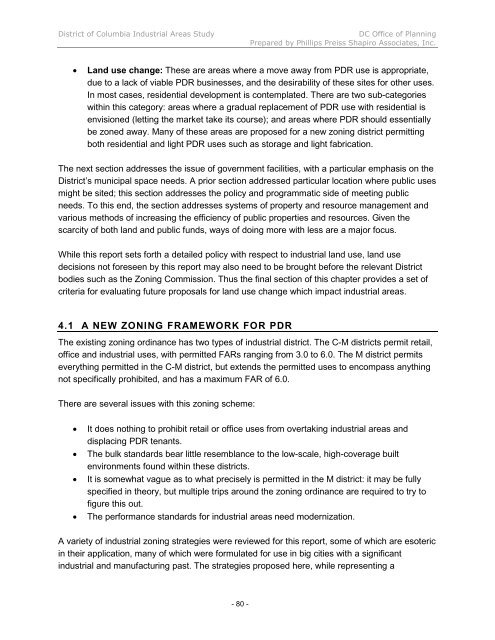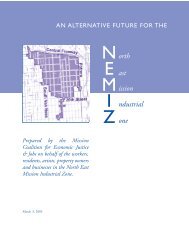INDUSTRIAL LAND IN A POST-INDUSTRIAL CITY District of ...
INDUSTRIAL LAND IN A POST-INDUSTRIAL CITY District of ...
INDUSTRIAL LAND IN A POST-INDUSTRIAL CITY District of ...
Create successful ePaper yourself
Turn your PDF publications into a flip-book with our unique Google optimized e-Paper software.
<strong>District</strong> <strong>of</strong> Columbia Industrial Areas Study DC Office <strong>of</strong> Planning<br />
Prepared by Phillips Preiss Shapiro Associates, Inc.<br />
Land use change: These are areas where a move away from PDR use is appropriate,<br />
due to a lack <strong>of</strong> viable PDR businesses, and the desirability <strong>of</strong> these sites for other uses.<br />
In most cases, residential development is contemplated. There are two sub-categories<br />
within this category: areas where a gradual replacement <strong>of</strong> PDR use with residential is<br />
envisioned (letting the market take its course); and areas where PDR should essentially<br />
be zoned away. Many <strong>of</strong> these areas are proposed for a new zoning district permitting<br />
both residential and light PDR uses such as storage and light fabrication.<br />
The next section addresses the issue <strong>of</strong> government facilities, with a particular emphasis on the<br />
<strong>District</strong>’s municipal space needs. A prior section addressed particular location where public uses<br />
might be sited; this section addresses the policy and programmatic side <strong>of</strong> meeting public<br />
needs. To this end, the section addresses systems <strong>of</strong> property and resource management and<br />
various methods <strong>of</strong> increasing the efficiency <strong>of</strong> public properties and resources. Given the<br />
scarcity <strong>of</strong> both land and public funds, ways <strong>of</strong> doing more with less are a major focus.<br />
While this report sets forth a detailed policy with respect to industrial land use, land use<br />
decisions not foreseen by this report may also need to be brought before the relevant <strong>District</strong><br />
bodies such as the Zoning Commission. Thus the final section <strong>of</strong> this chapter provides a set <strong>of</strong><br />
criteria for evaluating future proposals for land use change which impact industrial areas.<br />
4.1 A NEW ZON<strong>IN</strong>G FRAMEWORK FOR PDR<br />
The existing zoning ordinance has two types <strong>of</strong> industrial district. The C-M districts permit retail,<br />
<strong>of</strong>fice and industrial uses, with permitted FARs ranging from 3.0 to 6.0. The M district permits<br />
everything permitted in the C-M district, but extends the permitted uses to encompass anything<br />
not specifically prohibited, and has a maximum FAR <strong>of</strong> 6.0.<br />
There are several issues with this zoning scheme:<br />
It does nothing to prohibit retail or <strong>of</strong>fice uses from overtaking industrial areas and<br />
displacing PDR tenants.<br />
The bulk standards bear little resemblance to the low-scale, high-coverage built<br />
environments found within these districts.<br />
It is somewhat vague as to what precisely is permitted in the M district: it may be fully<br />
specified in theory, but multiple trips around the zoning ordinance are required to try to<br />
figure this out.<br />
The performance standards for industrial areas need modernization.<br />
A variety <strong>of</strong> industrial zoning strategies were reviewed for this report, some <strong>of</strong> which are esoteric<br />
in their application, many <strong>of</strong> which were formulated for use in big cities with a significant<br />
industrial and manufacturing past. The strategies proposed here, while representing a<br />
- 80 -












